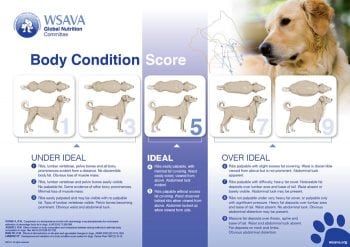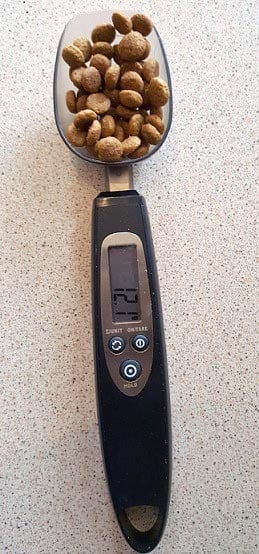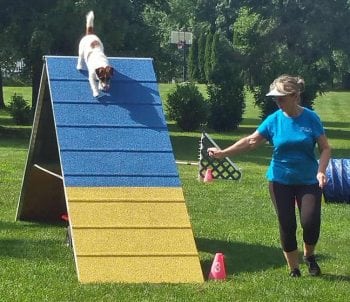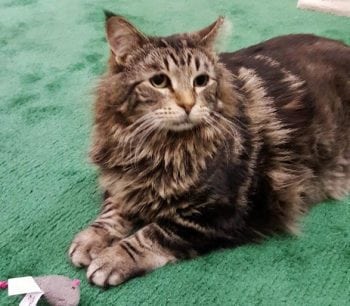1 Oct 2018
Marge Chandler discusses programmes to advise owners for weight management and genetic preconditions of some breeds in regards to obesity.

Three aspects to managing obesity exist:
Three steps to effectively managing obese patients are:
1. The recognition of obesity and establishing client commitment.
2. The development of a programme that meets the needs of the pet and owner.
3. Communication and follow-up with the health care team.
Components included in weight loss programmes are behaviour modification, diet and exercise (Murphy, 2016). For successful pet weight loss, the owner must undertake significant behaviour changes. A discussion emphasising the pet’s quality of life and health, and health risks of obesity, may help in addressing the pet’s obesity with owners who are sensitive about the issue – especially with overweight owners.
Avoid the use of pejorative terms when talking to the owner; for example, do not refer to their pet as greedy – it is food motivated – and some people find “overweight” better than “fat”. Some pets are genetically prone to obesity and explaining this may decrease some of the feelings of blame or shame, as these owners may be struggling with some powerful hormonal dynamics driving their pet to eat.

For owners who do not yet recognise their pet is overweight, a demonstration of body condition scoring can help (Figures 1 and 2). Owners often do not recognise where their pet is on a body condition chart, so a careful explanation may be needed (Eastland-Jones et al, 2014). If possible, showing a comparison of the pet’s weight before it became overweight can be helpful. Cat owners may not recognise that weight gain from 4.5kg to 5kg in a cat is a nearly 10% gain, equivalent to a 70kg human gaining about 7kg.
Specific recommended guidance includes information about measuring, monitoring and recording food intake, monitoring bodyweight and condition, and increasing the pet’s daily exercise. Adapt the suggested changes to the owner and pet, make sure you write them down and ensure the owner agrees.
The first part of weight management is a nutritional assessment, including a good diet history, bodyweight, body condition score and muscle condition evaluation (WSAVA, 2018). Owners may be feeding the amount on the label recommendations, but not realising the treats, snacks and dental chews are adding calories to the diet. Use of the American Veterinary Medical Association (AVMA) dog and cat questionnaires may be helpful to identify feeding patterns and obstacles the owner perceives could hamper a weight loss programme (AVMA, 2018). The estimated calories required for weight loss can be calculated. Numerous recommendations for equations have been published for caloric restriction for weight loss. A good starting point is to use resting energy requirement (RER) at ideal weight (iRER).
RER = bodyweight (kg)0.75 × 70

Using 80% of iRER is sometimes recommended, but may result in a more drastic food reduction. A programme should sufficiently restrict calories to produce weight loss without being so severe the pet is chronically hungry and the owner feels guilty about enforcing the diet. Severe restriction may also be more likely to result in regaining weight after the diet has ended. Starvation will result in weight loss, but causes excess loss of lean body mass, affects body functions (such as cardiovascular system), risks causing potentially fatal hepatic lipidosis in cats and is ethically questionable.
Therapeutic diets designed for weight loss are low in calories and fat, with other nutrients increased to avoid deficiencies. Protein is often increased to help maintain lean body mass and possibly promote satiety. Fibre content may be increased to a moderate or high level to increase satiety and may help promote a “lean” gut microbiome.
While most commercial weight loss products can be used successfully, a large variability in caloric density exists, so read the label and calculate calorie content, if not supplied. “Lite” diets are often not sufficiently low in calories for weight loss as they are only 10% lower in calories than the regular version of the same diet. Feeding less of a maintenance food may result in a deficiency of protein, minerals or vitamins.
Weight loss programmes should be tailored to the individual pet and closely monitored. While research animals can lose 1% to 2.5%/week, in pets weight loss of 0.8% to 1%/week for dogs and 0.5% to 1%/week for cats is more realistic.
As owners enjoy giving treats or using them as training rewards, consider incorporating treats at 10% or less of total calories. Treats may include hand-fed, low-calorie pet diet, low-calorie foods (baby carrots, air popped popcorn or cooked vegetables) or limited commercial low-fat treats. The treats should make up no more than 10% of the daily calorie intake.
Using smaller food bowls or feeding cups may result in smaller meals (Murphy et al, 2012). Ideally, food should be weighed as even with the use of graduated measuring cups, food portions are unreliable compared to weighed food portions. A spoon with built-in scales is useful for weighing small amounts of food for cats or small dogs (Figure 3). Minor variations in food intake can lead to weight gain over time.

Dividing the daily food into multiple meals can decrease hunger and the owner’s perception of their pet’s hunger, as well as possibly use a few calories from the thermic effect of food. Cat owners should know normal cat feeding behaviour usually involves multiple small meals, so that if the cat only eats a small amount of the food at one meal it does not necessarily mean the cat does not like the food, and it may not be necessarily to offer a different, more palatable food immediately.
Regular exercise expends energy, builds and maintains lean muscle mass and reduces boredom-related eating in people and in pets (Figure 4). Exercise alone rarely results in weight loss, but providing scheduled exercise, enrichment toys can help with prevention of weight gain in dogs and cats.
In humans it is becoming evident it is healthier to be fit and fat than unfit and lean, so exercise is encouraged for most pets, although joint, heart or other disorders may limit the amount or type of exercise possible.
Around 80% of people who lose weight regain some or all of it (Wing and Phelan, 2005). Similarly, around half of 33 dogs that had lost weight regained it – especially if switched back to a maintenance diet (German et al, 2012).
After weight loss, metabolic rate and energy expenditure decrease, so fewer calories are required to regain weight than to put it on initially. Weight loss may result in decreased plasma concentration of leptin, increased levels of ghrelin and suppressed fat oxidation, all leading to a risk of weight gain.
Owners may report that when they feed very little, the pet begs, and it is impossible to maintain the weight loss. Similarly, the rate of weight loss may decrease during a weight loss programme and a plateau may be reached; owners should be prepared for this so they do not become discouraged. While reaching an ideal weight may have been the goal, it is important for owners to realise any weight loss is beneficial. For example, in obese dogs, a 6% to 8% loss is associated with improvement in the signs of arthritis (Marshall et al, 2010).
In humans, those who avoid significant weight regain maintain a high level of physical activity, eat a low-fat diet, and actively monitor bodyweight (Wing and Phelan, 2005). Encouraging owners to exercise dogs and play with cats is important. Continued use of an appropriate low-fat or weight loss diet is recommended rather than feeding a maintenance diet. Continued veterinary or weight clinic visits aid in monitoring and provides an opportunity for assessment and counselling. Pets in less structured programmes are more likely to regain lost weight.
Preventing obesity is vital as it is better to avoid obesity than to deal with losing weight. Childhood human obesity predicts adult obesity, and the same appears to be true for puppies and kittens (Serisier et al, 2013). Of course, lean puppies and kittens may still become overweight as adults.
Weight management should be ideally discussed as part of the nutritional assessment that should take place at every visit to the clinic. This should be discussed before the pet gains weight.
Neutering reduces the calorie intake of dogs and cats by 24% to 33%, regardless of the pet’s age at neutering. This is due to a reduction in basal metabolic rate and/or increased food intake (Eirmann, 2016). Therefore, it is imperative to discuss feeding and diet with owners at the time their pet is neutered. Owners should be taught to body condition score their pet, and provided with suggestions for frequency of weighing. Activities or exercise can help in weight maintenance.
A recommendation of two 30-minute sessions of walks or playing is recommended for dogs; cats like shorter periods, so four 10-minute sessions per day is suggested (Pet Food Manufacturers Association, 2014).

Some dogs and cats have, like some humans, a genetic predisposition to obesity. Multiple genetic processes contribute to obesity, including effects on metabolism, and the hormones governing appetite and energy expenditure (Fawcett and Barroso, 2010; Romeiu et al, 2017).
In humans, a genetic effect appears on the amount of highly palatable foods (compared to less palatable foods) eaten, called an hedonic effect, as well as a decreased sensitivity to fullness or satiety (Llewellyn and Fildes, 2017; Van der Klaauw and Farooq, 2015). These appetite regulation mechanisms’ genetic effects likely occur in pets.
A tendency exists for some dog and cat breeds to become overweight, indicating a genetic role in the tendency to gain weight. Labrador retrievers, Shetland sheepdogs, golden retrievers, cocker spaniels, dachshunds, miniature schnauzers, springer spaniels, Chihuahuas, bassets hounds and pugs are more likely to be obese than other breeds (Lusby and Kirk, 2009). Less data exists about obesity risks in cat breeds, although Oriental, Birman and Persian cats appear to be affected less frequently, and mixed breed and domestic short-haired cats may be more at risk than purebred cats (Lund et al, 2005; Öhlund et al, 2018; Figure 5). A genetic component has been recognised in the development of being overweight in cats (Häring et al, 2011).
A mutation in the proopiomelanocortin (POMC) gene has been found in some Labrador retrievers and flatcoated retrievers. The mutation in this gene causes these dogs to have an increased appetite and feel hungry even if they have already eaten, potentially causing obesity. For each copy of the mutation, a dog will be, on average, 1.9kg heavier than dogs without the POMC mutation.
Around one in four (23%) UK Labrador retrievers carry at least one copy of the mutation. The mutation is significantly more common in Labrador retrievers selected to become assistance dogs than pets, perhaps because their food motivation makes them easier to train. This mutation is also present in flat-coated retrievers, where two-thirds carry at least one copy of this mutation. This mutation could also occur in crossbred dogs, with Labrador retrievers or flat-coated retrievers in their parentage (Raffan et al, 2016; Mankowska et al, 2017).

Epigenetic changes affect how genes are expressed. Potential epigenetic effects affecting methylation levels have been found to differ in lean and obese humans. Genetic expression is potentially reversible by changes in methylation. (Rönn et al, 2013; Corella et al, 2011; Romieu et al, 2017; Lai et al, 2018). So, while DNA cannot be changed, the expression of genes and the effects they have can be modified. Some can be modified by diet (nutrigenomics) and exercise. Having “obesity genes” does mean greater care will likely be needed to prevent obesity and, if it occurs, it may be more difficult to treat. The AHT can test for the POMC mutation, which will help owners know if their dogs are identified as being at risk for obesity.
An adaptation of the Dog Obesity Risk Assessment questionnaire could be a useful measure of canine eating behaviour and management factors associated with the tendency of a dog to gain weight (Raffan et al, 2015). The questionnaire addresses three dog factors (food responsiveness and satiety, lack of selectivity and interest in food) and four owner factors (owner motivation to control dog weight, owner intervention to control dog weight, restriction of human food and exercise taken), as well as gastrointestinal disease and poor health. Understanding that their dog’s weight will be difficult to control may make it easier for owners to understand they must do more about diet and exercise than other owners.
A lean body condition and calorie restriction is proven scientifically to improve quality of life and concurrently extend lifespan in pets.
Obesity has numerous adverse effects on health and longevity, but implementation of a weight loss programme and maintenance of good body condition in dogs and cats has continued to be a challenge for vets, pets and owners. Prevention of obesity must become a priority for the veterinary health care team.